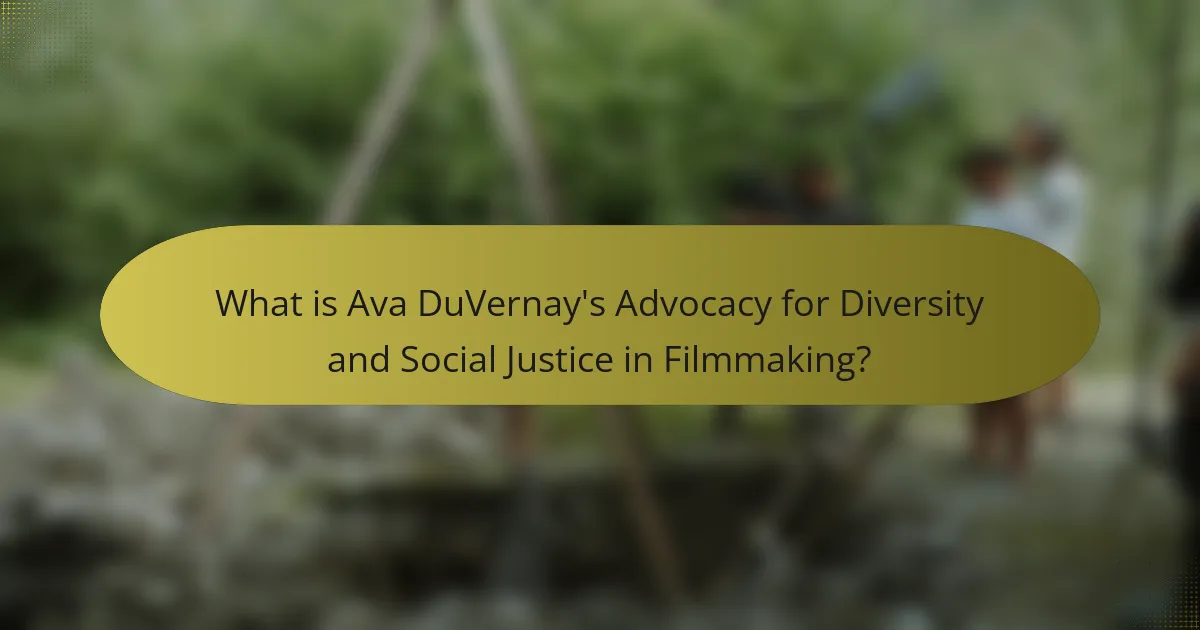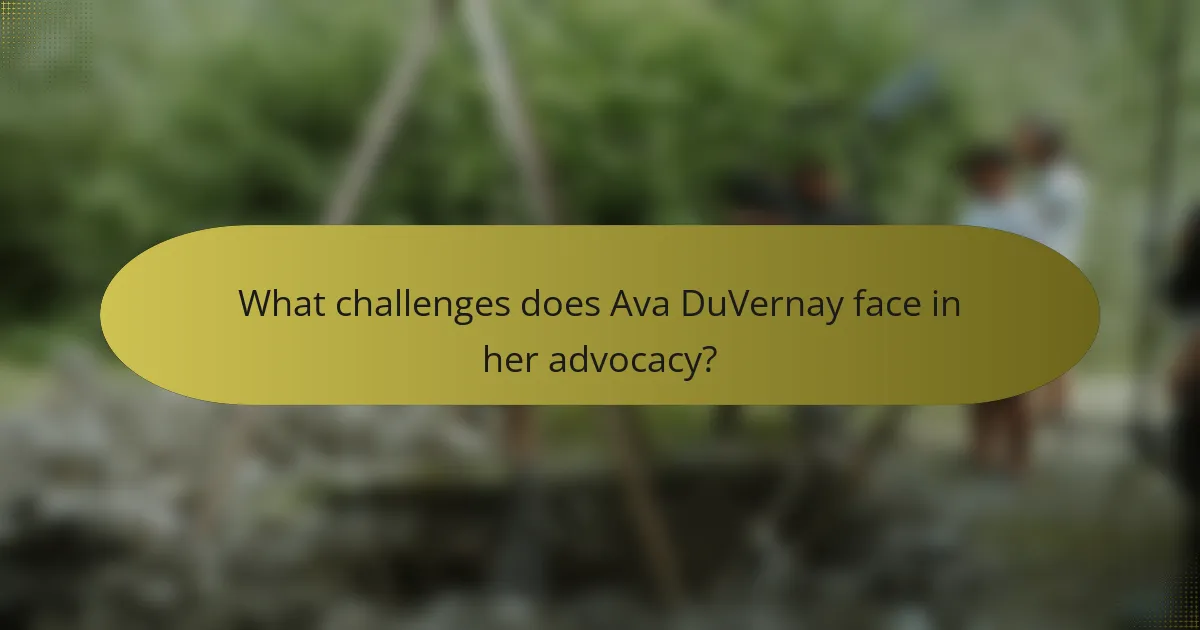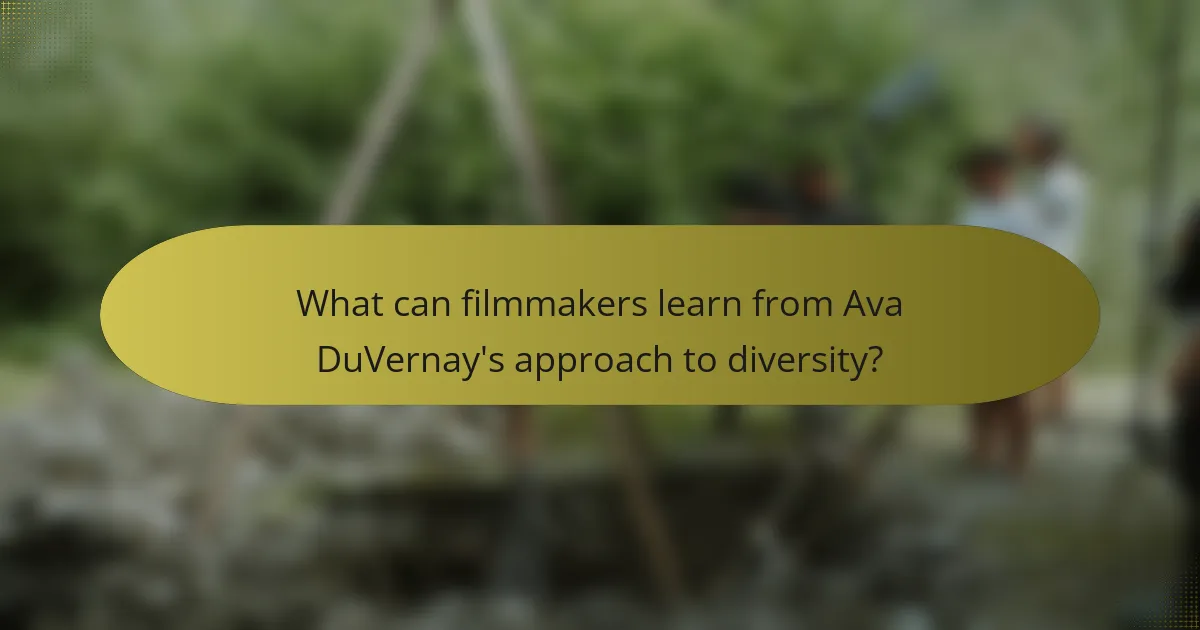Ava DuVernay is a prominent filmmaker and advocate for diversity and social justice in the film industry. She promotes underrepresented voices through her distribution company, ARRAY, which focuses on films created by women and people of color. DuVernay’s work, including the film “Selma,” addresses critical issues of civil rights and social justice, fostering dialogue around race and equality. Despite facing systemic racism, financial barriers, and resistance from industry gatekeepers, she remains committed to reshaping the landscape of filmmaking. Her initiatives, such as the ARRAY Alliance, highlight the significance of inclusive storytelling and representation in creating impactful narratives.

What is Ava DuVernay’s Advocacy for Diversity and Social Justice in Filmmaking?
Ava DuVernay advocates for diversity and social justice in filmmaking by promoting underrepresented voices. She emphasizes the importance of inclusive storytelling. DuVernay founded ARRAY, a distribution company focused on films by women and people of color. This initiative aims to amplify diverse narratives in the film industry. Her film “Selma” highlights civil rights and social justice issues. DuVernay’s work encourages dialogue around race and equality. She actively participates in discussions about representation in Hollywood. Through her efforts, she seeks to reshape the industry landscape for future filmmakers.
How did Ava DuVernay become an advocate for diversity in the film industry?
Ava DuVernay became an advocate for diversity in the film industry through her own experiences and initiatives. She faced challenges as a woman of color in Hollywood. DuVernay’s commitment to representation is evident in her work. She directed the film “Selma,” which highlighted civil rights issues. This film showcased the importance of diverse narratives. DuVernay also founded the nonprofit organization ARRAY. ARRAY focuses on amplifying the voices of women and people of color in film. Her advocacy includes mentoring emerging filmmakers. DuVernay’s efforts have led to increased awareness and dialogue about diversity in the industry.
What personal experiences influenced her advocacy?
Ava DuVernay’s advocacy was influenced by her personal experiences with racial inequality. Growing up in Los Angeles, she faced systemic racism and discrimination. These experiences shaped her understanding of social justice issues. DuVernay’s early career in public relations exposed her to media representation challenges. She recognized the lack of diversity in Hollywood narratives. Her documentary “13th” highlighted racial disparities in the criminal justice system. This film was rooted in her desire to address historical injustices. DuVernay’s advocacy continues to focus on amplifying marginalized voices in film.
What milestones in her career highlight her commitment to diversity?
Ava DuVernay’s career milestones that highlight her commitment to diversity include directing the film “Selma.” This film portrays the civil rights movement and emphasizes the importance of representation. DuVernay also created the documentary “13th,” which examines racial inequality in the United States. This work has sparked discussions on systemic racism. She founded the distribution company ARRAY to support diverse filmmakers. ARRAY focuses on amplifying underrepresented voices in cinema. DuVernay’s involvement in the “Time’s Up” movement further showcases her dedication to gender equality. Each of these milestones reflects her ongoing advocacy for diversity in the film industry.
Why is diversity and social justice important in filmmaking?
Diversity and social justice are essential in filmmaking because they ensure representation and equity in storytelling. Diverse voices bring unique perspectives and experiences to the screen. This representation allows audiences to see themselves in the stories being told. Social justice in filmmaking challenges stereotypes and promotes inclusivity. It also encourages the industry to address systemic inequalities. Research shows that diverse films perform better at the box office. For example, a study by the Annenberg Inclusion Initiative found that films with diverse casts significantly outperform those without. This highlights the economic benefits of diversity in filmmaking.
How does diversity impact storytelling in film?
Diversity significantly enhances storytelling in film by introducing varied perspectives and experiences. It allows for richer character development and more relatable narratives. Diverse stories reflect the complexities of society and foster empathy among audiences. Research shows that films with diverse casts and crews perform better at the box office. A study by McKinsey & Company found that films with greater ethnic diversity in their casts earned 29% more in revenue. This demonstrates that diversity not only enriches the narrative but also contributes to commercial success.
What social justice issues are prevalent in the film industry?
Social justice issues prevalent in the film industry include representation, gender inequality, and racial discrimination. Representation refers to the lack of diverse voices and stories in mainstream cinema. Gender inequality manifests in the underrepresentation of women in key creative roles. Racial discrimination is evident in both casting practices and storytelling. Studies show that women directed only 12% of the top-grossing films in 2019. Additionally, people of color are often cast in stereotypical roles, limiting their opportunities. Ava DuVernay’s work highlights these disparities and advocates for change. Her film, “Selma,” emphasizes the importance of authentic representation in storytelling.
What initiatives has Ava DuVernay launched to promote diversity?
Ava DuVernay has launched several initiatives to promote diversity in filmmaking. She founded the ARRAY organization, which focuses on amplifying the voices of women and people of color in the film industry. ARRAY distributes films by underrepresented filmmakers and provides educational resources. DuVernay also created the “The 52nd Annual NAACP Image Awards” to celebrate diverse talent. Additionally, she established the “Ava DuVernay Fellowship” to support emerging filmmakers from marginalized backgrounds. Her initiatives aim to create equitable opportunities and representation in media.
What is the significance of the ARRAY Alliance?
The ARRAY Alliance is significant for promoting diversity and inclusion in the film industry. Founded by Ava DuVernay, it aims to support underrepresented filmmakers. The organization provides resources, education, and networking opportunities. ARRAY focuses on amplifying the voices of women and people of color in storytelling. This initiative addresses systemic barriers in Hollywood. It fosters a more equitable landscape for diverse narratives. By advocating for change, ARRAY influences industry practices and policies. The alliance has been instrumental in creating a platform for marginalized creators.
How do her films reflect her advocacy for social justice?
Ava DuVernay’s films reflect her advocacy for social justice through powerful storytelling and representation. Her work often highlights systemic racism and inequality. For instance, “Selma” portrays the civil rights movement’s struggle for voting rights. This film emphasizes the importance of activism and collective action. Additionally, “13th” examines the intersection of race, justice, and mass incarceration. It provides historical context and contemporary relevance. DuVernay’s narratives prioritize marginalized voices. She aims to challenge stereotypes and promote understanding. Through her films, she sparks conversations about social justice issues.
How does Ava DuVernay collaborate with other filmmakers for diversity?
Ava DuVernay collaborates with other filmmakers to promote diversity through initiatives like ARRAY. ARRAY is a nonprofit organization she founded to support filmmakers of color and women directors. DuVernay actively partners with diverse creators on projects, providing them with platforms and resources. She emphasizes mentorship and inclusion in her filmmaking process. DuVernay has also participated in panels and discussions to advocate for equitable representation in the industry. Her efforts have led to increased visibility for underrepresented voices in cinema. By creating opportunities for collaboration, she fosters a more inclusive film community.
Who are some key collaborators in her projects?
Ava DuVernay collaborates with various key individuals in her projects. Notable collaborators include Oprah Winfrey, who produced “Selma” and starred in “A Wrinkle in Time.” David Oyelowo is another significant collaborator, having portrayed Martin Luther King Jr. in “Selma.” Additionally, she frequently works with cinematographer Bradford Young, who contributed to “Selma” and “A Wrinkle in Time.” DuVernay also partners with screenwriter Jill Blankenship on projects like “Queen Sugar.” These collaborations emphasize her commitment to diverse storytelling and representation in film.
What strategies does she use to foster inclusive filmmaking?
Ava DuVernay employs several strategies to foster inclusive filmmaking. She prioritizes diverse storytelling by highlighting underrepresented voices. DuVernay actively collaborates with a wide range of talent from various backgrounds. This includes writers, directors, and crew members who reflect different perspectives. She also advocates for equitable hiring practices within the industry. DuVernay’s initiative, ARRAY, supports and promotes films by women and people of color. Additionally, she emphasizes the importance of authentic representation in narratives. Her commitment to mentorship helps emerging filmmakers gain access to resources and opportunities. These strategies collectively contribute to a more inclusive filmmaking environment.

What challenges does Ava DuVernay face in her advocacy?
Ava DuVernay faces significant challenges in her advocacy for diversity and social justice in filmmaking. One challenge is the systemic racism present in the film industry. This often results in limited opportunities for filmmakers of color. Additionally, she contends with financial barriers that can hinder independent projects. These barriers often restrict the creative freedom necessary for impactful storytelling. Furthermore, DuVernay confronts resistance from industry gatekeepers who may not prioritize diverse narratives. This resistance can lead to difficulties in securing funding and distribution for her projects. Lastly, she navigates public scrutiny and backlash for her outspoken views on social issues. These challenges collectively complicate her advocacy efforts.
How do systemic issues in Hollywood affect her efforts?
Systemic issues in Hollywood hinder Ava DuVernay’s advocacy efforts. These issues include racial and gender disparities in hiring practices. Data shows that women and people of color are underrepresented in key filmmaking roles. This lack of representation limits diverse storytelling and perspectives. Additionally, funding and support for projects focused on social justice can be scarce. The systemic bias within the industry often leads to fewer opportunities for marginalized voices. Consequently, her initiatives face significant obstacles in reaching wider audiences.
What resistance has she encountered in promoting diversity?
Ava DuVernay has encountered significant resistance in promoting diversity in filmmaking. This resistance often stems from entrenched industry biases. Many decision-makers in Hollywood prioritize traditional narratives over diverse stories. Financial concerns also play a role; investors may hesitate to fund projects with unfamiliar perspectives. Additionally, there is a lack of representation in key positions within studios and production companies. This limits opportunities for diverse filmmakers. Critics sometimes dismiss her work as niche, undermining its broader relevance. Despite these challenges, DuVernay continues to advocate for inclusivity and representation in the industry.
How does she address criticism related to her advocacy?
Ava DuVernay addresses criticism related to her advocacy by engaging in open dialogue. She often responds to critiques through social media platforms. DuVernay emphasizes the importance of constructive conversations. She highlights the need for diverse voices in storytelling. DuVernay also shares her experiences to provide context for her advocacy. She uses her platform to educate others about systemic issues. This approach fosters understanding and collaboration. Her commitment to transparency reinforces her credibility in the industry.
What impact has Ava DuVernay’s advocacy had on the film industry?
Ava DuVernay’s advocacy has significantly influenced the film industry by promoting diversity and inclusion. She has raised awareness about the underrepresentation of people of color and women in filmmaking. DuVernay founded the distribution company ARRAY to amplify diverse voices in cinema. Her work on projects like “Selma” and “13th” has sparked critical conversations around race and justice. She has also been instrumental in initiatives like the #OscarsSoWhite movement. This movement highlighted the lack of diversity in Oscar nominations and led to reforms within the Academy. DuVernay’s efforts have inspired a new generation of filmmakers to pursue their stories. Her advocacy continues to push for systemic change across the industry.
How have her efforts influenced other filmmakers?
Ava DuVernay’s efforts have significantly influenced other filmmakers by promoting diversity and social justice in the industry. Her work has inspired many to prioritize inclusive storytelling. She established the ARRAY Alliance, which supports filmmakers of color. This initiative has encouraged others to create platforms for underrepresented voices. DuVernay’s films, such as “Selma” and “13th,” highlight systemic injustices. These projects have prompted discussions on race and equality in cinema. Her advocacy for equitable hiring practices has led to increased awareness among industry leaders. As a result, more filmmakers are now committed to diversity in their projects.
What measurable changes have occurred in diversity representation since her advocacy began?
Since Ava DuVernay’s advocacy began, diversity representation in filmmaking has significantly improved. The percentage of lead roles for people of color in major films rose from 12% in 2014 to 28% in 2020. Female directors of color increased from 3% to 10% within the same period. Additionally, the inclusion of diverse writers in Hollywood projects has seen a 20% increase. DuVernay’s initiatives, such as the ARRAY organization, have supported over 100 films by women and people of color. These measurable changes reflect a growing commitment to diversity in the film industry.

What can filmmakers learn from Ava DuVernay’s approach to diversity?
Filmmakers can learn the importance of inclusive storytelling from Ava DuVernay’s approach to diversity. DuVernay emphasizes the need for diverse voices in film. She advocates for representation both in front of and behind the camera. Her work demonstrates that authentic narratives resonate with broader audiences. For instance, her film “Selma” highlights the civil rights movement through a diverse lens. DuVernay also founded the ARRAY Alliance to support underrepresented filmmakers. This initiative showcases her commitment to equity in the industry. By prioritizing diversity, filmmakers can create richer, more relatable content.
What best practices can be derived from her initiatives?
Ava DuVernay’s initiatives highlight several best practices in promoting diversity and social justice in filmmaking. First, she emphasizes the importance of representation in storytelling. This ensures that diverse voices and experiences are authentically portrayed. Second, she advocates for equitable hiring practices within the industry. This approach increases opportunities for underrepresented talent both in front of and behind the camera. Third, DuVernay encourages collaboration with grassroots organizations. This fosters community engagement and amplifies marginalized perspectives. Additionally, she utilizes platforms like social media to raise awareness and mobilize support for social justice causes. These practices have been effective in creating a more inclusive film industry. They serve as a model for others aiming to drive change in their respective fields.
How can emerging filmmakers incorporate social justice themes in their work?
Emerging filmmakers can incorporate social justice themes by focusing on authentic storytelling that reflects diverse perspectives. They should research social issues relevant to their communities. This involves understanding the historical context and current implications of these issues. Filmmakers can collaborate with activists and organizations to ensure accuracy and depth. They should prioritize representation in casting and crew to amplify marginalized voices. Utilizing platforms like social media can help spread awareness and engage audiences. An example is Ava DuVernay’s work, which emphasizes racial equality and justice. Her films often highlight systemic injustices, making them accessible and relatable. This approach fosters dialogue and encourages viewers to reflect on social issues.
What resources are available for filmmakers seeking to promote diversity?
Filmmakers seeking to promote diversity can access various resources. Organizations like the Sundance Institute offer grants and mentorship programs focused on underrepresented voices. The Black List provides a platform for diverse screenwriters to showcase their work. Additionally, the Geena Davis Institute on Gender in Media advocates for gender equality in film. The Coalition of Asian Pacifics in Entertainment promotes Asian representation in Hollywood. Filmmakers can also utilize social media networks to connect with diverse talent and audiences. These resources aim to enhance inclusivity in the film industry.
How can audiences support diversity in filmmaking?
Audiences can support diversity in filmmaking by actively choosing to watch films that feature diverse casts and stories. This behavior encourages studios to invest in projects that represent a variety of perspectives. Additionally, audiences can engage with filmmakers on social media to express support for diverse storytelling. By sharing and promoting films made by underrepresented creators, audiences amplify these voices. Supporting film festivals that focus on diversity also contributes to the visibility of these works. Research shows that films with diverse representation perform well at the box office, demonstrating market demand. This financial success can influence future productions to prioritize diversity.
What actions can viewers take to advocate for inclusive storytelling?
Viewers can advocate for inclusive storytelling by actively supporting diverse content. They should seek out and promote films and shows that feature underrepresented voices. Engaging in discussions about representation on social media platforms is also essential. Writing reviews that highlight inclusive elements can influence others’ viewing choices. Additionally, viewers can participate in campaigns that demand diversity in media. Supporting organizations that promote equity in storytelling further amplifies their advocacy. Attending film festivals that showcase diverse filmmakers can help elevate these narratives. Lastly, viewers can provide feedback to creators and platforms, urging them to prioritize inclusivity in their projects.
How can audiences engage with diverse films and filmmakers?
Audiences can engage with diverse films and filmmakers by actively seeking out films from underrepresented communities. This includes watching films from various cultures, ethnicities, and perspectives. Attending film festivals that focus on diversity also enhances engagement. Events like the African American Film Festival and the Asian American International Film Festival showcase diverse voices. Participating in discussions and panels after screenings fosters deeper understanding. Audiences can also support filmmakers by sharing their work on social media. Engaging with filmmakers directly through Q&A sessions or virtual meet-and-greets creates a personal connection. Supporting streaming platforms that prioritize diverse content is another effective way to engage. Data shows that diverse storytelling enriches the film industry and broadens audience perspectives.
Ava DuVernay is a prominent advocate for diversity and social justice in filmmaking, emphasizing the importance of inclusive storytelling and representation. She founded ARRAY, a distribution company dedicated to amplifying films by women and people of color, and her notable works, including “Selma” and “13th,” highlight critical social issues. The article explores DuVernay’s personal experiences that shaped her advocacy, the milestones in her career, and the initiatives she launched to promote diversity in the film industry. It also examines the challenges she faces, the impact of her efforts on the industry, and the strategies that filmmakers can adopt to foster inclusivity.